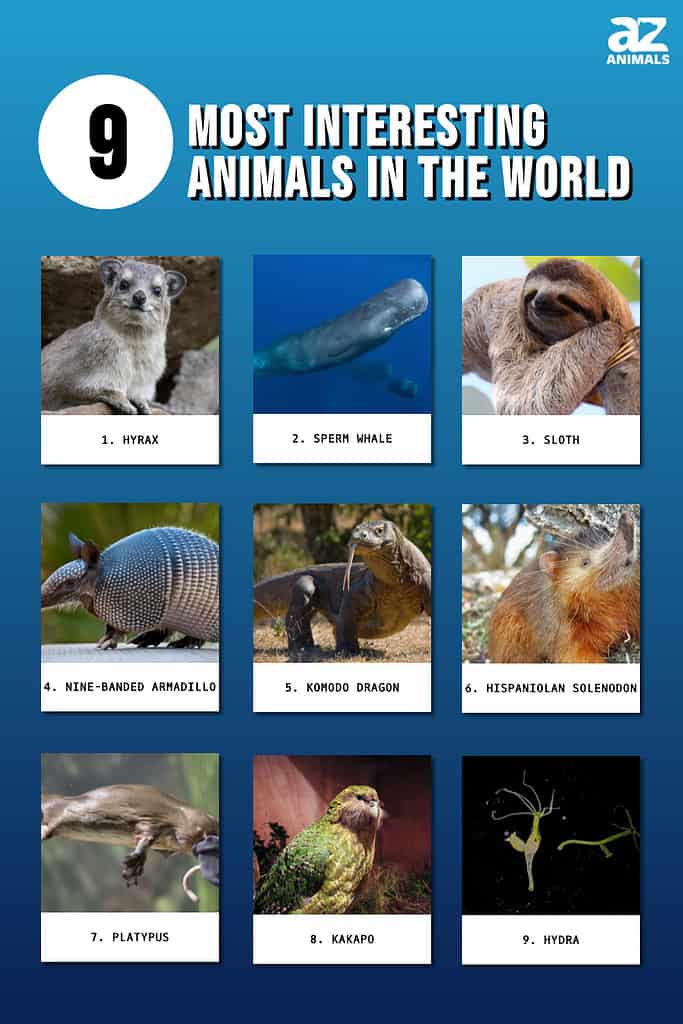
Key Points:
- The endangered kakapo, only found in New Zealand, is the only flightless parrot in the world.
- Native to the island of Hispaniola, the Hispaniolan solenodon is a burrowing animal that looks like a cross between a shrew and a rat.
- The sperm whale is the largest toothed carnivore, has the largest brain, and makes the loudest sound on earth.
Every animal is interesting, but some animals are more interesting than others. The fascination may come from the way the animal looks, behaves, reproduces, or a combination of some or all of those characteristics. This blog takes a look at nine of the most fascinating animals in the world and examines what makes them so irresistibly interesting:
9. Hydra

The fact that hydras don’t appear to age at all is one of the many fascinating facts about them.
©Rattiya Thongdumhyu/Shutterstock.com
Hydras are tiny animals that live in freshwater. They not only have a weird reproductive cycle but they can regenerate their tissues and do not seem to age, even though they can die. In fact, scientists speculate that, under proper conditions, a hydra could live for 1400 years, or even forever.
Hydras can reproduce sexually or asexually. When times are flush, they simply grow buds that eventually snap off and grow into other hydras that are clones of their parents. However, when food is scarce or the climate inhospitable, they reproduce sexually. They produce ovaries, testes, or sometimes both on the same individual. The testes release sperm into the water that eventually fertilizes the eggs in the ovaries of another hydra.
These fertilized eggs develop a tough coat, and when the adult dies these fortified eggs sink to the bottom of the body of water and wait for conditions to improve. When they do, the egg hatches into a hydra nymph.
8. Kakapo
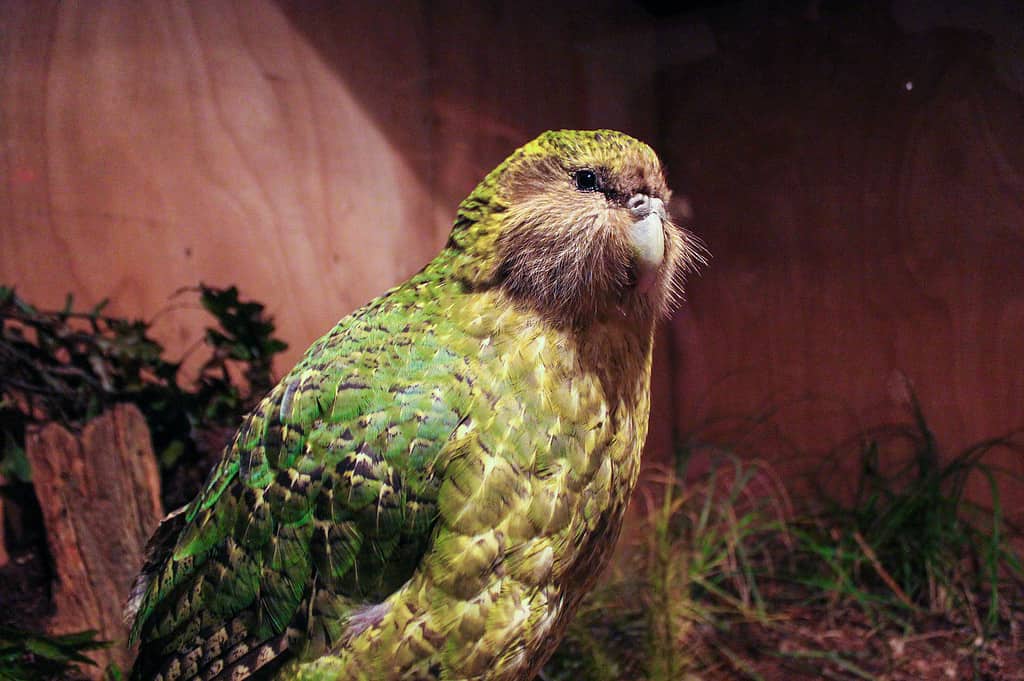
Kakapo sightings are exceedingly rare.
©Imogen Warren/Shutterstock.com
The kakapo, which is only found in New Zealand, is the only flightless parrot in the world. It is a large, nocturnal bird, with a length of 23 to 25 inches and a weight of between 2 and 9 pounds. It has a facial disc that makes it look somewhat owl-like, and so has the other name of owl parrot.
Yet its wings and tail are short, and it lacks a keel on its breastbone. Its fluffy feathers are olive green and mottled with brownish-gray or black, which allows it to blend into its forest home, where it lives on the ground.
The bird, which can live to be 100 years old, was widespread until the arrival of humans and the predatory animals they brought with them. Now, the kakapo is critically endangered and is only found on New Zealand’s Codfish and Anchor Islands.
During mating season, male kakapos clear out an area, dig a shallow hole in the dirt to sit in, go into a trance-like state, and make booming sounds similar to a foghorn. They can do this booming, which travels several kilometers, all night long for 3-5 months in hopes of attracting a female mate.
Read here for more information about the kakapo.
7. Platypus

Sensing its prey through electrolocation, the platypus is an intriguing mammal.
©John Carnemolla/Shutterstock.com
Who isn’t fascinated by the platypus, a mammal with a duck’s bill that lays eggs and whose males have venomous spurs on their back legs? Not only this, but the platypus and its equally weird fellow monotreme, the echidna, can find prey by sensing electrical fields. They are the only mammals that can do this, not counting the Guiana dolphin.
The platypus does this through receptors in its bill. Its tiny eyes are more like those of a hagfish than a mammal and have double cones. The animal also glows blue-green while under black light.
While the female has two ovaries, only the left one works. When her babies hatch out of their eggs, they aren’t fed milk from teats, which the mother doesn’t have, but from dermal pores. The babies are actually born with teeth but lose them.
Grown platypuses use tough plates in their bills to grind up their food. People used to eat their tails, which are full of fat. The average platypus lives about 12 years in the wild and about 17-20 years in captivity.
Read here for more information about the platypus.
6. Hispaniolan Solenodon

The nocturnal Hispaniolan Solenodon is one of the last two surviving insectivorous mammals native to the Caribbean.
©Seb az86556 / CC BY-SA 3.0 – License
This creature, which looks like a cross between a large rat and a shrew, is found in the forests and shrublands of Haiti and the Dominican Republic. It is one of two land animals that are native to the island of Hispaniola.
The solenodon has a body that ranges between 19 and 28 inches in length and a nearly naked tail that can be nearly 10 inches long. Its lifespan is about 11-12 years.
It weighs a bit less than two pounds. It is fossorial and comes out at night to eat small animals, including insects, worms, and mice. The female has two teats, on her back, near her rump. But the really fascinating thing about the solenodon is that it is truly venomous. The venom delivered by a solenodon can kill a mouse in a matter of minutes.
Though it won’t kill a human, the bite of a solenodon is very painful indeed.
Read here for more information about solenodons.
5. Komodo Dragon
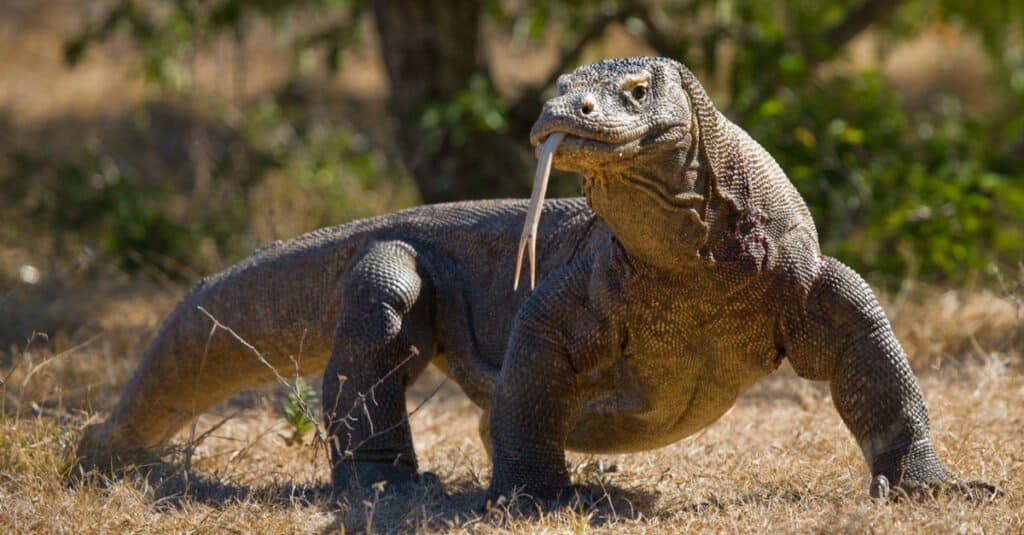
An
apex predator
, the Komodo dragon occasionally attacks humans.
©GUDKOV ANDREY/Shutterstock.com
Is this Indonesian animal, the world’s largest monitor lizard really venomous? Some biologists claim that it’s not but that its saliva is so filthy with bacteria that a bite inevitably sends the victim into septic shock and kills them. Whether the lizard is truly venomous or not, it is an ambush predator that usually doesn’t let its prey go off and die the way a venomous snake does but tears out its throat and lets it bleed out.
Then, the dragon will either tear off and swallow chunks of the prey or swallow it whole if it’s small enough. If a group of dragons comes upon a corpse, the biggest male eats first.
Like a snake, the Komodo dragon projects a breathing tube under its tongue to let it breathe while it eats. Then, it will regurgitate a gastric pellet of indigestible material such as horn and hair. Despite its prowess as a hunter, the Komodo dragon seems to prefer carrion.
the lifespan of a Komodo Dragon is between 25-30 years. Unfortunately, the rumors about it digging up and eating human corpses appear to be true.
Read here for more information about Komodo dragons.
4. Nine-banded Armadillo
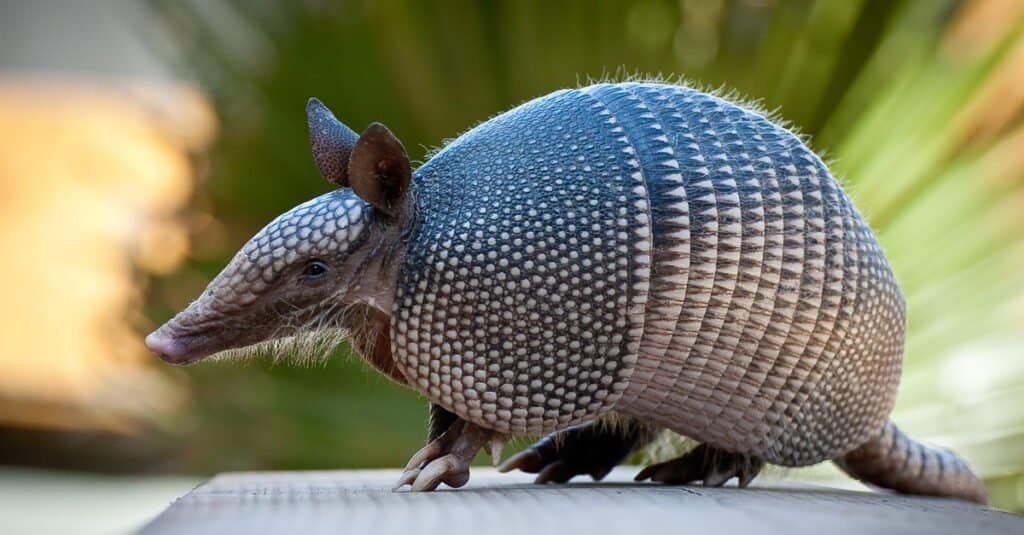
Unlike three-banded armadillos, nine-banded armadillos cannot roll into a ball. However, they can float on water by inflating their intestines or sinking to run across riverbeds.
©Heiko Kiera/Shutterstock.com
Once found only in South America, the armadillo has slowly moved north to Central America, the American southwest and north to Nebraska, and east to North Carolina. It is famous for its armor, which is made of bony plates covered with scutes.
Some species of armadillo are flexible enough to roll up into a ball when they’re threatened, while the nine-banded armadillo jumps four feet into the air when it’s scared.
The armadillo’s reproductive strategy is also fascinating. Though only one egg is fertilized, it doesn’t implant in the uterus right away. When it does implant, it splits into quadruplets. This is normal and expected. The offspring go on to live 7-8 years in the wild or 15-20 years in captivity.
The armadillo is also one of the few animals that can contract leprosy and is a disease reservoir for the Trypanosoma cruzi parasite. This parasite causes the ghastly Chagas disease.
Read here for more information about armadillos.
3. Sloth
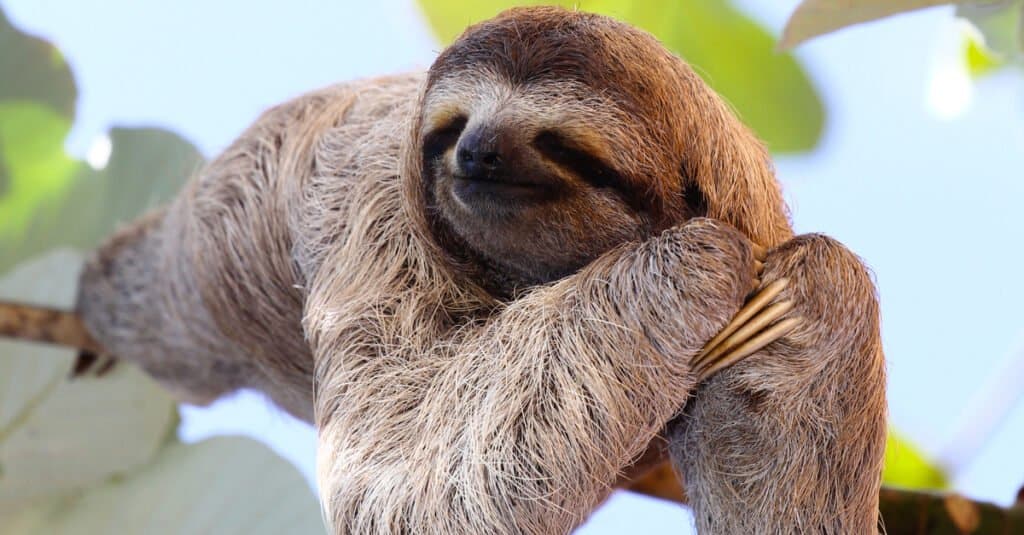
Sloths have poor hearing and rely on their sense of smell and touch to find food.
©Janossy Gergely/Shutterstock.com
This South and Central American mammal whose very name is a word for one of the seven deadly sins likes nothing better than to hang upside down in its favorite tree. It eats, sleeps, mates, gives birth, and even dies hanging upside down in a tree. The average sloth lives 20-30 years in the wild, but has been known to live over 40 years in captivity.
The only thing it doesn’t do in its tree is relieving itself. Then, it will climb ever-so-slowly down the tree, drag itself to the spot where it always does its business, then very slowly climb back up. Biologists do not know why the sloth leaves its tree to do this of all activities, for it makes it subject to predation.
Moreover, the sloth has a symbiotic relationship with algae, which grows in its fur and turns it green. A microcosm of arthropods, including moths, mites, and beetles also live in the animal’s fur. Sloths are also a bit cold-blooded, as their body temperature is dependent on their environment.
The temperature of a normal, healthy sloth is between 77 to 95 degrees Fahrenheit. If the body temperature drops to as low as 68 degrees, the animal goes into torpor or a deeper torpor than it’s already in. Other interesting facts about sloths are:
- Sloths can’t walk. The arms of the three-toed sloth are 50 percent longer than its legs.
- The long arms make it an excellent swimmer. The sloth can hold its breath for 40 minutes underwater.
- Unlike most mammals, it doesn’t always have seven vertebrae in its neck. It can have more or less depending on the species.
Read here for more information about the sloth.
2. Sperm Whale

The sperm whale’s blowhole is on the left side of its head, which is unusual among cetaceans.
©Martin Prochazkacz/Shutterstock.com
The sperm whale is one of the most fascinating marine mammals. Hunted nearly to extinction for the sperm oil in its head, this huge and intelligent animal is still vulnerable to extinction even as it’s found in most of the oceans of the world. It’s the largest toothed carnivore, has the largest brain, and makes the loudest sound on earth. It has a complex repertoire of vocalizations that help it communicate with other sperm whales and find prey.
These vocalizations are learned, not innate. Since this whale dives deeper than any other marine mammal, it uses echolocation to hunt in the lightless depths of the ocean. The whale, also called the cachalot, can dive as deep as 6600 feet in search of one of its favorite meals, the giant squid.
Not only does the whale produce sperm oil, but it also makes ambergris in its gut. Ambergris is still used in perfume and is sometimes found washed up on beaches. Indeed, it is vomited up because it’s made when the indigestible beaks of squid irritate the whale’s digestive system and the whale secretes a lubricant to ease the irritation.
Sperm whales also sleep vertically with their heads just beneath the surface of the water, and no one knows why. One thing scientists do know about sperm whales is that they typically live 70 years.
Read here for more information about sperm whales.
1. Hyrax

Surprisingly, the hyrax is more closely related to elephants and manatees, versus other animal species that look more similar, such as the pika.
©Bartosz Budrewicz/Shutterstock.com
The hyrax or “dassie” is the most interesting animal in the world. The hyrax looks like a cross between a rabbit and a guinea pig and looks like it should be either a lagomorph or a rodent. Found in East and Southern Africa and the Middle East, it is neither.
Its closest relatives are the elephant and, amazingly, the manatee. It even grows tusks that keep growing throughout its life (average 9-14 years), and its cheek teeth are like those of a rhinoceros.
The nails on its feet are less like nails than hooves, and there’s a gland on its back that secretes pheromones. When the babies are born they climb on their mother’s back and lie on this gland, which helps them to imprint.
As omnivorous animals, these hyraxes mainly consume herbs, grasses, fruit, and leaves, supplementing their diet with small lizards, insects, and eggs of birds, caught when sunbathing on local rocks
Like a horse, the hyrax can’t vomit, and like a cow, it has a multi-chambered stomach. It still can’t break down cellulose as well as a cow, and it is frankly cold-blooded. To warm up, the hyrax needs to bask in the sun like a reptile.
Read here for more information about the hyrax.
Bonus: Three More Interesting Animals For Your Consideration
Animals don’t have to be weird to be interesting. We’ve added a trio that didn’t quite make the list – a tiny pink sand-dweller and two relentless bullies. Two of them just want to eat – the other sometimes bullies other creatures just for fun. Does that make it even more terrifying? Decide for yourself!
Pink Fairy Armadillo
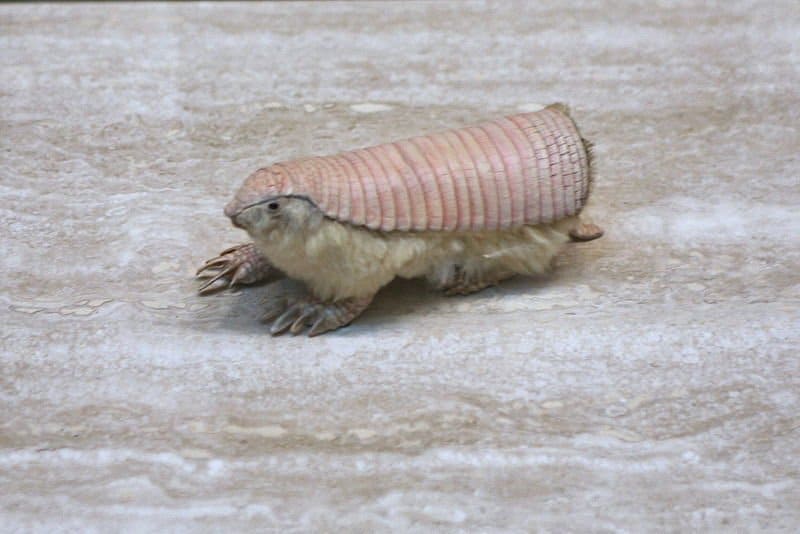
Pink Fairy Armadillos live in the sandy plains of Argentina and other parts of South America.
©Cliff / CC BY 2.0 – License
Have you ever seen a tiny pink armadillo that is small enough to fit in your hand? Unless you live in South America or have seen one at a zoo – you probably haven’t. This little creature spends most of its life underground in the sandy plains and grasslands of Argentina. It is also known as the “sand swimmer” because of how quickly and easily it navigates underground.
The pink fairy armadillo’s dorsal shell is not completely attached to its body like other armadillos and is not used for protection. Instead, it helps the animal to regulate its body temperature. This interesting armadillo sports soft, white fur and large, reptilian claws for digging. Plus, it’s pink. Move over platypus!
Honey Badger
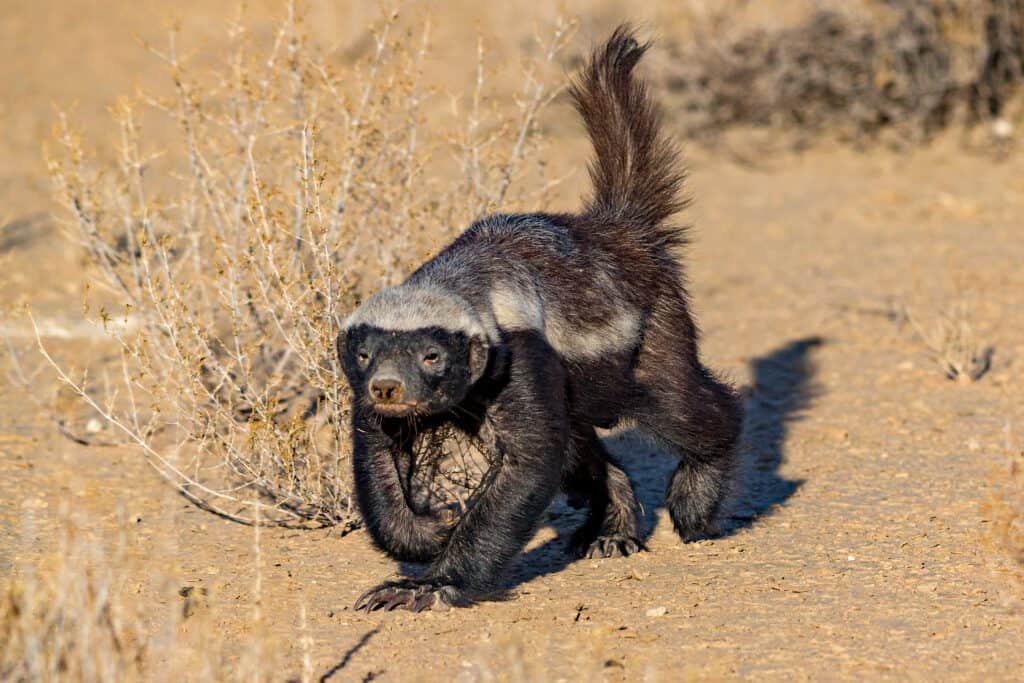
Honey Badgers are intelligent animals that require constant stimulation!
©Braam Collins/Shutterstock.com
You may have seen the popular YouTube video that narrates a slice of life of the strangely interesting honey badger and claims that the animal “just don’t care. Actually, it does care – about eating – and it doesn’t care if it gets stung by bees, bitten by snakes, or challenged by lions – it will pursue its prey relentlessly until it is satisfied!
Honey badgers are voracious omnivores that eat anything from honeybee larvae to snakes to roots and berries. They are related to skunks, otters, ferrets, and other badgers – but they are a member of the weasel family. Not the most elegant of hunters, honey badgers just bully their prey to death with their sharp teeth and claws and muscular build. Nothing stops them – they are bitten so many times by venomous snakes that they have developed immunity, dozens of bee stings are merely an inconvenience – their hide is loose and thick to prevent other animals from biting them.
These tough creatures can be found bullying their way throughout most of Sub-Saharan Africa, Saudi Arabia, Iran, and western Asia. They adapt to any condition from hot rainforests to cold mountaintops. Of course, they can!
Killer Whales

Killer whales have been recorded bullying and killing
whale sharks
and other large animals.
©Vladimir Turkenich/Shutterstock.com
There is nothing run-of-the-mill about killer whales. From their striking appearance to their amazing intelligence – the orca has been a beloved staple of aquarium and water shows around the world. Orcas are actually the largest member of the Dolphin family – mammals – but recently, they have been nothing short of cold-blooded killers.
Pods of orcas act like wolf packs – working together to harass and kill animals as large as whale sharks. Their most interesting trait of late is killing great white sharks and eating just their livers – leaving their carcasses to wash onto beaches in South Africa. They have learned that the livers are a superfood packed with extra energy – and they seem to have passed this knowledge on to their friends. Their taste for violence has increased recently with several disturbing trends. These animals have been turning over boats and have been seen bullying their dolphin cousins – just for the heck of it.
Killer whales roam most of the world’s oceans consuming up to 500 pounds of food per day. While humans aren’t currently on their menus – I wouldn’t risk swimming where these unpredictable animals are seen.
Summary of the 9 Most Interesting Animals in the World
Let’s recap 9 animals we found to be some of the most interesting on our planet:
| Rank | Animal |
|---|---|
| 1 | Hyrax |
| 2 | Sperm Whale |
| 3 | Sloth |
| 4 | Nine-banded Armadillo |
| 5 | Komodo Dragon |
| 6 | Hispaniolan Solenodon |
| 7 | Platypus |
| 8 | Kakapo |
| 9 | Hydra |
The photo featured at the top of this post is © Bartosz Budrewicz/Shutterstock.com
Thank you for reading! Have some feedback for us? Contact the AZ Animals editorial team.






